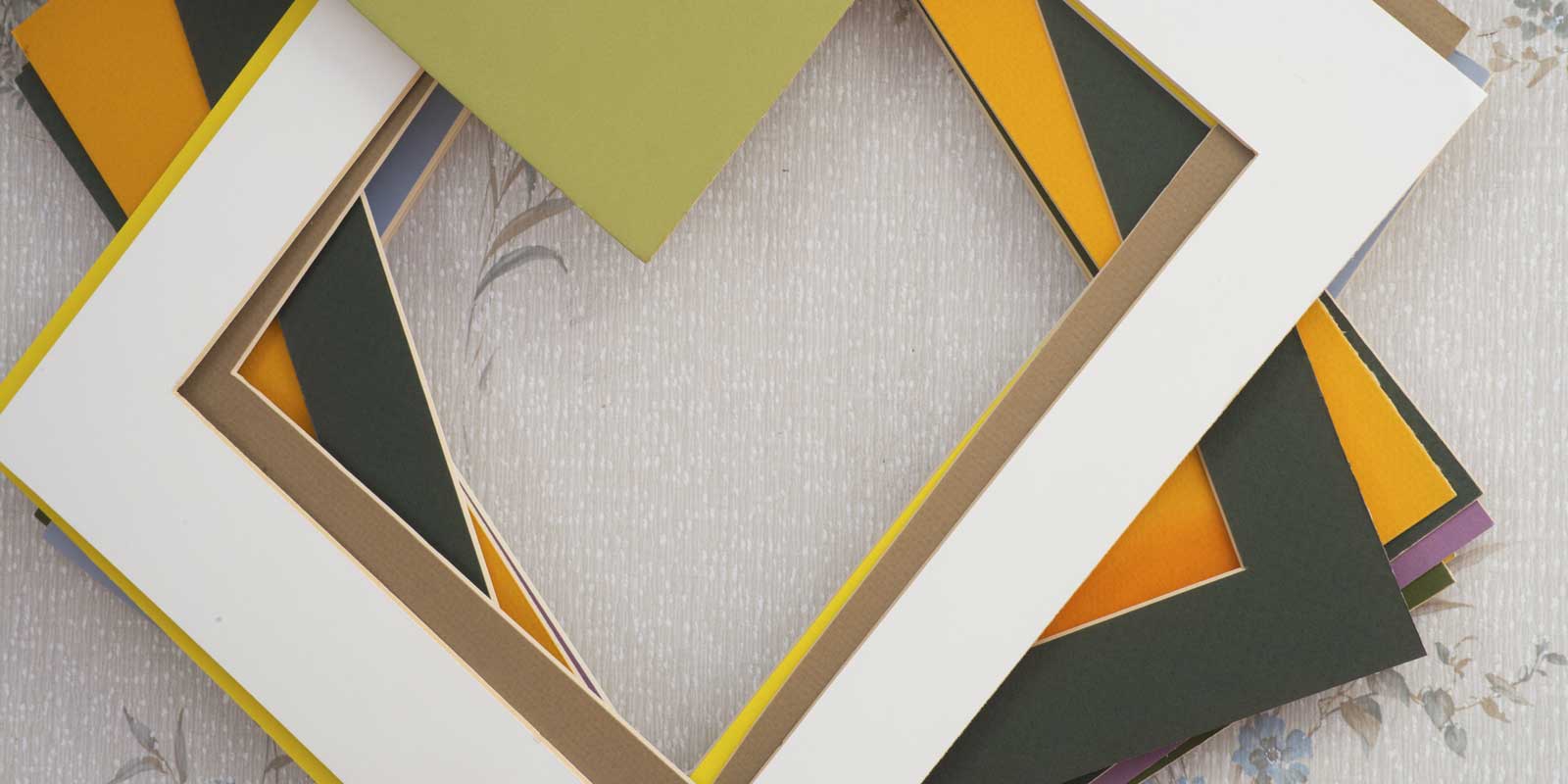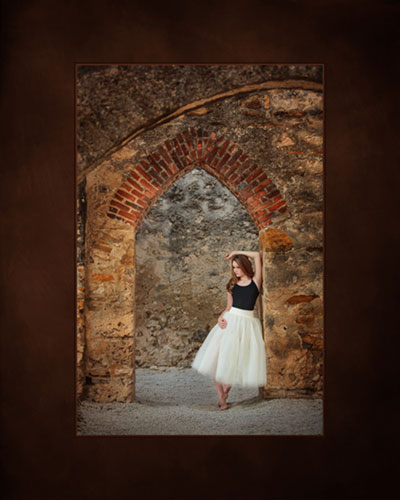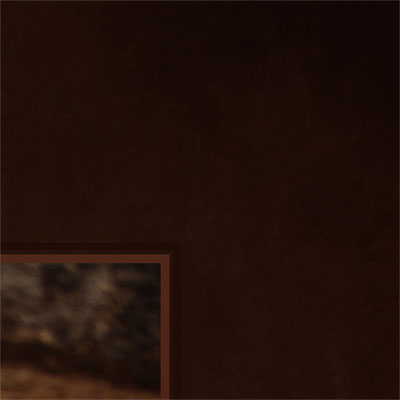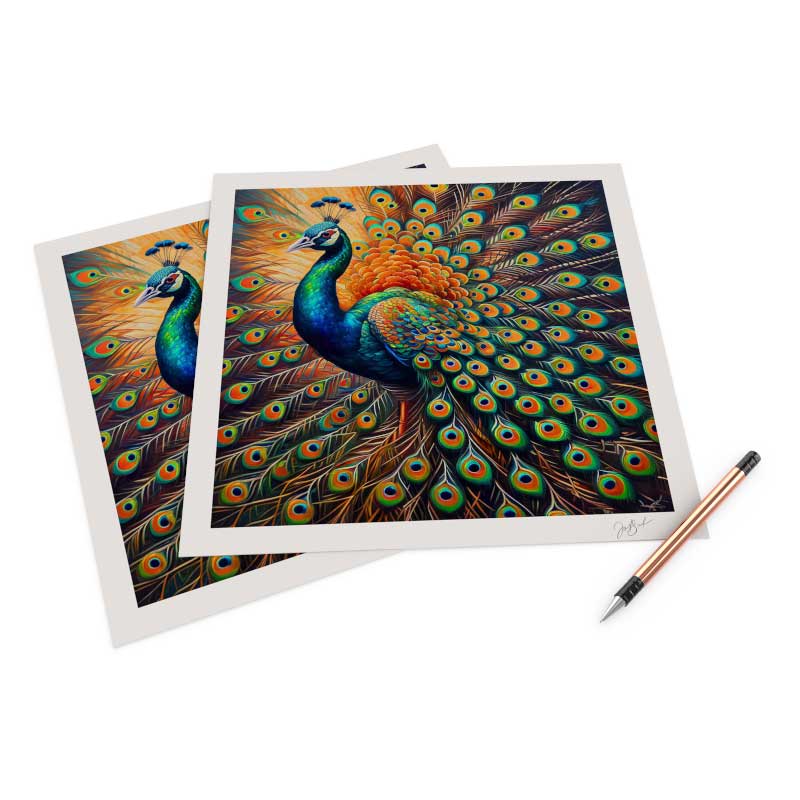There is a lot of emphasis on choosing a frame for your art and photo prints but sometimes overlooked is the importance of matting. Not only does the mat help highlight the artwork, it also acts as protection so the glass or acrylic does not come in direct contact with the print.
Ever since we added our full service in-house framing other questions pertaining to matting have also arisen. The top question is if we offer custom mats. The other questions are usually related to the size of the mat, appearance or the archival properties of the mat. Other times it might have something to do with using a mismatched print with a larger frame. Below I talk about what some of these issues mean.
Do you offer custom cut mats?
That is a BIG YES! You can actually visit our framing section where we have custom mat options. which can be ordered online. You select both the outer width and height and the window size and we cut them custom to order. It makes it extremely easy to have mats tailored to the size you prints that you will not find at an art supply store. At FinerWorks you can also order the mats as you order prints on any of our papers. In those cases it is even easier because all you have to do is select the outer size of the matting.
Print Size vs Mat Size
If you are going to mat your prints, I always recommend choosing to have your print made with either the ½ inch or 1 inch border. As an example if you have a print which is an 8×10 and the mat window is sized for an 8×10, that extra border going around the 8×10 image will give the cut sheet ample size to secure to the back of the matting.
We had a customer frustrated that none of the mats at her local art supply store had a mat with an exact 8×10 window. She was afraid that some of her artwork would be cut off, most notably the signature would be only partially visible. This problem was because unless you are custom cutting your mats yourself any mat will have a window slightly smaller than the printed artwork. Again using that 8×10 example, the window will likely measure ⅛ to ¼ smaller. Imagine if you tried to mat a 8×10 borderless print and the window was also 8×10. You would have the problem of the print wanting to fall through the opening or at least not very will nested within the mat window.
There might be instances in which you actually choose a mat with a larger opening than the print’s total sheet size. In this type of display the print will appear to float between the mat window edges. I have seen this seems to be popular in instances in which a print has a deckled or torn edge (which we now offer). On a side note about floating prints, if you opt to not have a mat, make sure you have some sort of spacer so the glass does not come in direct contact with the print. Our framing department actually uses these spacers for framed prints that do not have a mat. These are basically plastic strips that are inserted just behind the lip of the frame which gives the needed space.
As is the case with most things related to decor, there are trends in matting. One framing supply company I know indicates on their website that the now days people seem to opt for wider mats meaning the space between thin mat window and the edge is greater compared to a couple decades ago in which people opted for thinner margin on the matting. I see this with photography as well. Right now it seems a more favorable display for fine art photography is a minimal frame with a wide mat. This is my own personal favorite way to display photos since it gives a nice contemporary look. One other advantage with the larger mat style is it can ultimately give a smaller print a more expansive presence on the wall.
Mat Color
When it comes to choosing a mat color, there seems to be some consensus among professionals I have spoken to that what is most important is the color does not draw your attention away from the artwork itself. I would also add that today there is a trend for people to choose bolder colors when painting their walls. If you have framed and/or matted prints on display somewhere for sale, be aware that any color other than white might play a role in your buyer’s decision on the purchase of that print or not. I say other than white because white tends to be both a safer and neutral color and less likely to clash with the wall.

Mat Materials and Archivability
Choose a mat which is not going to harm the print over time. There are 3 primary different types of mat materials: paper, alpha-cellulose, and rag. Paper mats are going to be your cheapest in quality and price. They are simply made from paper pulp. You want to stay away from the paper mat since overtime the acidity levels in these can harm the artwork in side. These are also typically the same mats found in cheap ready made frame kits you will see that the art and craft superstore or Walmart. The alpha-cellulose, made from wood pulp is engineered to be acid free while the rag mat is made of cotton which is naturally acid free. Incidentally most of our papers we print on are also either alpha-cellulose or cotton which makes the prints more archival. Also, all our mats are of the alpha-cellulose variety, more specifically the brand is called Artique Conservation Matboard.
Mismatched to Frame Size
At times you may find yourself in the need to mat an odd size print which is not exactly ideally suited for a frame you might have lying around. For instance, you might have a square 12×12 print and only have a 16×20 frame. You will likely need to have the mat custom cut so the outer dimensions matches the insert of the frame. Another popular choice is to bottom-weight the mat which means the bottom mat side is larger. I have seen some artists will further use that bottom margin to cut out an additional widow which might display the artworks title and the artist’s name.
Digital Mats
One other alternative to matting, yet which will give your artwork a matted look is to create a digital mat. This will give you the ultimate control in both color and the appearance of texture. Just the other day a photographer I know had us print up some photos for a competition he was entering them in. They all had a type of digital mat effect which enhanced the artwork considerably. When framed the print would be able to stand on it’s own without a physical mat. I seen this done quite often and have even seen some artists will add drop shadows and strategic bevels in the inner window edge to trick the eye even more into thinking a real mat is being used. Not until you get within inches of the print can you tell that it is not a real mat. When framing, the only thing I would recommend in this situation is to make sure you have some spacers between the print and the glass so it is not in direct contact if possible. Digital mats can be created with an image editing program like Photoshop or Photoshop Elements.<
Lisa Langell of Langell Photography shows you how to create an interesting digital mat in Photoshop. In it she actually uses part of the original image as part of the mat.
Do it Yourself Hinge Mat
Matting your prints is not difficult either. And it does not have to be expensive even if you need to cut out the mat window yourself. This is easily done with an exacto knife and a straight edge. Uncut matboards are readily available in different colors both online and offline at various art supply stores. Once your have cut your mat and the window opening its even easier to mat them with something called a “hinged mat”. Hinged mats are mats in which one side is has the window while the back side is solid. Hinged mats make an excellent way to display prints you might be offering for sale but don’t want to place in a frame. The following video illustrates how to create a hinged mat to display your prints.
My Account
If you are unable to locate a recent order in your order history, it is likely you may not have been logged into your accounbt prior to placing your order. To fix this, simply contact us and we will be happy to add the unassigned order to your account for you.
When someone completes the purchase of one of your offered prints, PayPal will send you a notification of the order details as well as your customer information. It is your responsibility to fulfill this order in a timely fashion by either having us fulfill the order or you ship it out yourself.
If you plan on using Finerworks to fulfill your order, you should check the shipping page for shipping rates to determine the shipping cost and then charge accordingly. Also consider reviewing our blog post titled What to Charge Your Customers for Shipping.
No. Buyers can only purchase printed works.
Only lower resolution web versions of the images are shown. These contain a watermark which provides some protection. If you are too worried that people will copy your web viewable images, we recommend not participating in the gallery experience.
This can be done using your gallery’s URL. The link will look something like this
https://geogalleries.com/my_username
Make sure you replace “my_username” with your actual name.
Note: If you used to use FinerWorks old gallery, your FinerWorks gallery url now automatically redirects people to your Geo Galleries link.
We do offer COAs as an option at checkout. You will see an option to order a COA once you add a print to your shopping cart
We will not notify sellers when a sale is made. FinerWorks is not involved in your sales and has no knowledge of transactions relating to gallery sales. Read more…
When someone buys one of your printed products, the order is automatically forwarded to FinerWorks for fulfillment and shipped to the buyer. Within 30 days, once the order ships, details of the order (including the buyer) will be available to you.
Currently, we do not offer custom URLs.
Aside from having artistic value, the image must be a suitable print quality/resolution. It must also be properly titled, include a well written description, and be submitted to the appropriate category and assigned to a collection.
Virtual Inventory gives you the ability to store “virtual” prints. Create and store as many prints as you wish, and when you are ready for us to print one, its only a matter of checking out. Use this quick video tutorial for a walk through the entire process.
FinerWorks virtual inventory is a system that allows artists and photographers to save their artwork as pre-configured products within their FinerWorks account. Instead of having to re-upload and set up a print’s specifications (like size, paper type, and framing) every time an order comes in, a virtual inventory item acts like a blueprint for a product. This streamlines the print-on-demand and order fulfillment process.
How It Works
The system is designed to simplify selling on third-party platforms like Shopify, Squarespace, WooCommerce or Etsy. Here’s a breakdown of the key steps:
- Create Virtual Inventory Items: An artist uploads their digital image to FinerWorks. They then create a virtual inventory item from this image, which involves specifying all the product details like size, print medium (e.g., giclée fine art paper, canvas), and framing options. Each virtual inventory item is assigned a unique **SKU** (Stock Keeping Unit) that begins with “AP”.
- Sync with an Online Store: The artist lists the product in their own online store (e.g., a framed print of their artwork). When they create the listing, they enter the unique SKU from FinerWorks’ virtual inventory into the SKU field of their store’s product variant.
- Order Fulfillment: When a customer purchases the product from the artist’s online store, the order is transmitted to FinerWorks through an integration app (e.g., for Shopify or Etsy). FinerWorks uses the SKU to identify the exact product from the virtual inventory and produces it on demand.
- Shipping and Branding: FinerWorks then prints, packages, and ships the product directly to the customer. The packing slip and shipping label can be customized with the artist’s name and logo, making it appear as though the order was shipped directly from them.
Key Advantages
- Efficiency: It eliminates the need for artists to manually set up each print each time they order, saving a significant amount of time, especially for those with high order volumes or who sell the same products repeatedly.
- Print on Demand: Artists don’t need to hold physical inventory. Prints are only created when an order is placed, reducing waste and financial risk.
- Integration: It connects an artist’s online storefront with FinerWorks’ fulfillment center, creating a smooth, automated workflow from sale to delivery.
We no longer differentiate between the two. A basic account is now the same as a gallery account.
As an on-demand printer, we must adhere to the same regulations and standards that anyone else does. To learn more about protecting your intellectual property, take time to read over one of our recent blogs here.
Yes, if the image was saved in your Inventory Files. From there you will find under each image of the file you will find a “Create Download Link” for a small fee of $1.50 USD.
See Video
Each registered account is intended for those who wish to print on demand, have the option to store their images with FinerWorks, and maintain a gallery. Users may opt to create personal galleries, sell prints from FinerWorks via their PayPal account, as well as sell from the Main FinerWorks Gallery.
You can do this by creating a virtual inventory of prints or cards. Once you have uploaded images to your account, you can set up individual giclee prints or cards with different sizes and styles. These will be stored in your Virtual Inventory. When you need to have an order dropshipped to your customer, go there and add the print you need to your cart.
No, you can create as many items as you’d like.
Occasionally, print products we have offered in the past have changed or have been discontinued. If those items can no longer be offered with the options selected then the item might automatically be removed.
Only images that are stored in your virtual inventory / my images can be used. Files you upload to temporary storage cannot be used.
Only if you want to use the Auto Export tool will syncing your products to your virtual inventory be necessary. Without that, we will not know what products to print and ship. Syncing involved making sure that your Virtual Inventory sku, matches your WooCommerce product sku.
Posting and Selling Prints
Currently, we do not offer custom URLs.
When someone buys one of your printed products, the order is automatically forwarded to FinerWorks for fulfillment and shipped to the buyer. Within 30 days, once the order ships, details of the order (including the buyer) will be available to you.
We will not notify sellers when a sale is made. FinerWorks is not involved in your sales and has no knowledge of transactions relating to gallery sales. Read more…
We do offer COAs as an option at checkout. You will see an option to order a COA once you add a print to your shopping cart
This can be done using your gallery’s URL. The link will look something like this
https://geogalleries.com/my_username
Make sure you replace “my_username” with your actual name.
Note: If you used to use FinerWorks old gallery, your FinerWorks gallery url now automatically redirects people to your Geo Galleries link.
FinerWorks virtual inventory is a system that allows artists and photographers to save their artwork as pre-configured products within their FinerWorks account. Instead of having to re-upload and set up a print’s specifications (like size, paper type, and framing) every time an order comes in, a virtual inventory item acts like a blueprint for a product. This streamlines the print-on-demand and order fulfillment process.
How It Works
The system is designed to simplify selling on third-party platforms like Shopify, Squarespace, WooCommerce or Etsy. Here’s a breakdown of the key steps:
- Create Virtual Inventory Items: An artist uploads their digital image to FinerWorks. They then create a virtual inventory item from this image, which involves specifying all the product details like size, print medium (e.g., giclée fine art paper, canvas), and framing options. Each virtual inventory item is assigned a unique **SKU** (Stock Keeping Unit) that begins with “AP”.
- Sync with an Online Store: The artist lists the product in their own online store (e.g., a framed print of their artwork). When they create the listing, they enter the unique SKU from FinerWorks’ virtual inventory into the SKU field of their store’s product variant.
- Order Fulfillment: When a customer purchases the product from the artist’s online store, the order is transmitted to FinerWorks through an integration app (e.g., for Shopify or Etsy). FinerWorks uses the SKU to identify the exact product from the virtual inventory and produces it on demand.
- Shipping and Branding: FinerWorks then prints, packages, and ships the product directly to the customer. The packing slip and shipping label can be customized with the artist’s name and logo, making it appear as though the order was shipped directly from them.
Key Advantages
- Efficiency: It eliminates the need for artists to manually set up each print each time they order, saving a significant amount of time, especially for those with high order volumes or who sell the same products repeatedly.
- Print on Demand: Artists don’t need to hold physical inventory. Prints are only created when an order is placed, reducing waste and financial risk.
- Integration: It connects an artist’s online storefront with FinerWorks’ fulfillment center, creating a smooth, automated workflow from sale to delivery.
Only lower resolution web versions of the images are shown. These contain a watermark which provides some protection. If you are too worried that people will copy your web viewable images, we recommend not participating in the gallery experience.
Aside from having artistic value, the image must be a suitable print quality/resolution. It must also be properly titled, include a well written description, and be submitted to the appropriate category and assigned to a collection.
No. Buyers can only purchase printed works.
If you plan on using Finerworks to fulfill your order, you should check the shipping page for shipping rates to determine the shipping cost and then charge accordingly. Also consider reviewing our blog post titled What to Charge Your Customers for Shipping.
When someone completes the purchase of one of your offered prints, PayPal will send you a notification of the order details as well as your customer information. It is your responsibility to fulfill this order in a timely fashion by either having us fulfill the order or you ship it out yourself.
Virtual Inventory
FinerWorks virtual inventory is a system that allows artists and photographers to save their artwork as pre-configured products within their FinerWorks account. Instead of having to re-upload and set up a print’s specifications (like size, paper type, and framing) every time an order comes in, a virtual inventory item acts like a blueprint for a product. This streamlines the print-on-demand and order fulfillment process.
How It Works
The system is designed to simplify selling on third-party platforms like Shopify, Squarespace, WooCommerce or Etsy. Here’s a breakdown of the key steps:
- Create Virtual Inventory Items: An artist uploads their digital image to FinerWorks. They then create a virtual inventory item from this image, which involves specifying all the product details like size, print medium (e.g., giclée fine art paper, canvas), and framing options. Each virtual inventory item is assigned a unique **SKU** (Stock Keeping Unit) that begins with “AP”.
- Sync with an Online Store: The artist lists the product in their own online store (e.g., a framed print of their artwork). When they create the listing, they enter the unique SKU from FinerWorks’ virtual inventory into the SKU field of their store’s product variant.
- Order Fulfillment: When a customer purchases the product from the artist’s online store, the order is transmitted to FinerWorks through an integration app (e.g., for Shopify or Etsy). FinerWorks uses the SKU to identify the exact product from the virtual inventory and produces it on demand.
- Shipping and Branding: FinerWorks then prints, packages, and ships the product directly to the customer. The packing slip and shipping label can be customized with the artist’s name and logo, making it appear as though the order was shipped directly from them.
Key Advantages
- Efficiency: It eliminates the need for artists to manually set up each print each time they order, saving a significant amount of time, especially for those with high order volumes or who sell the same products repeatedly.
- Print on Demand: Artists don’t need to hold physical inventory. Prints are only created when an order is placed, reducing waste and financial risk.
- Integration: It connects an artist’s online storefront with FinerWorks’ fulfillment center, creating a smooth, automated workflow from sale to delivery.
Virtual Inventory gives you the ability to store “virtual” prints. Create and store as many prints as you wish, and when you are ready for us to print one, its only a matter of checking out. Use this quick video tutorial for a walk through the entire process.
You can do this by creating a virtual inventory of prints or cards. Once you have uploaded images to your account, you can set up individual giclee prints or cards with different sizes and styles. These will be stored in your Virtual Inventory. When you need to have an order dropshipped to your customer, go there and add the print you need to your cart.
No, you can create as many items as you’d like.
Occasionally, print products we have offered in the past have changed or have been discontinued. If those items can no longer be offered with the options selected then the item might automatically be removed.
Only images that are stored in your virtual inventory / my images can be used. Files you upload to temporary storage cannot be used.
Only if you want to use the Auto Export tool will syncing your products to your virtual inventory be necessary. Without that, we will not know what products to print and ship. Syncing involved making sure that your Virtual Inventory sku, matches your WooCommerce product sku.
Giclee Printing at FinerWorks
One of the largest ranges of paper selections, while using the highest level of archival print technology allowing superior detail and color, you can create custom giclee prints of your artwork and photos.




It’s interesting to know that matting takes a lot of work to get right. I will keep that in mind when getting acrylic photo printing services someday. Getting that print matted will help a lot in preparing it to be displayed.